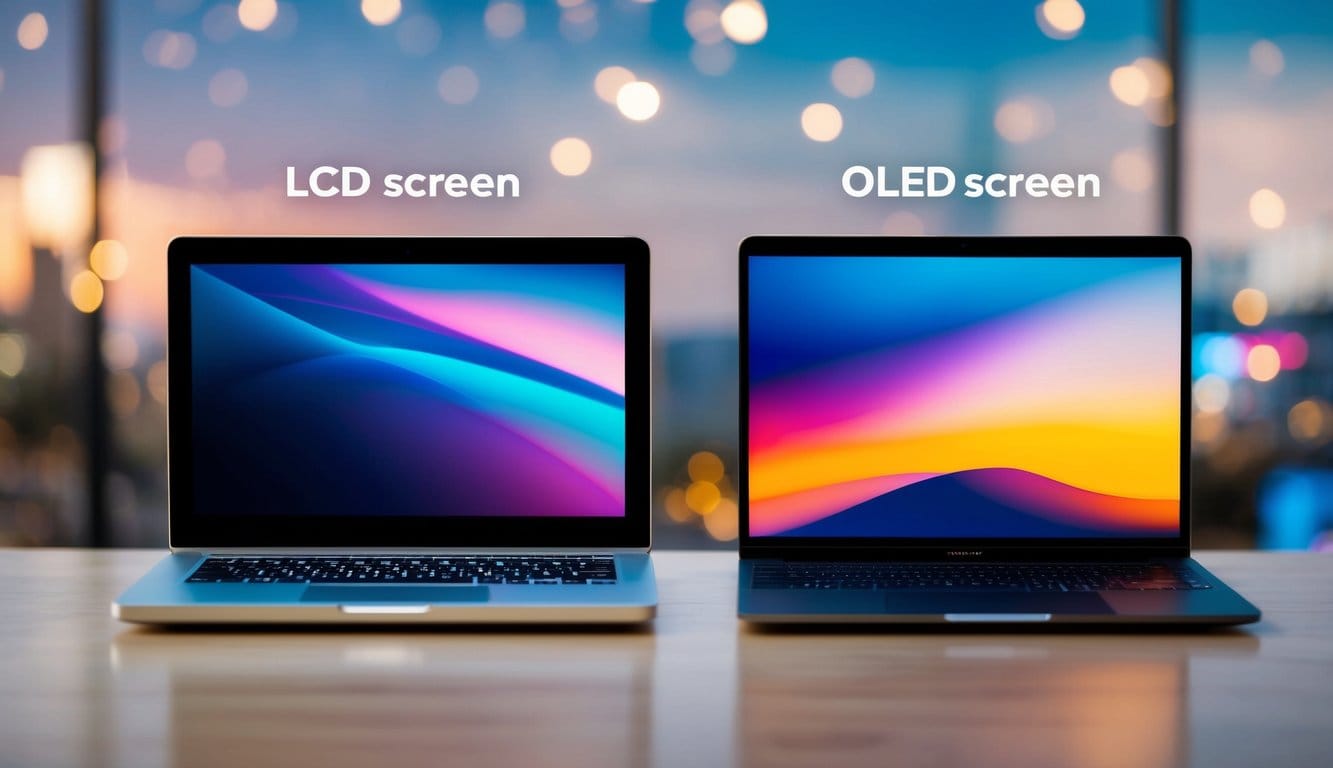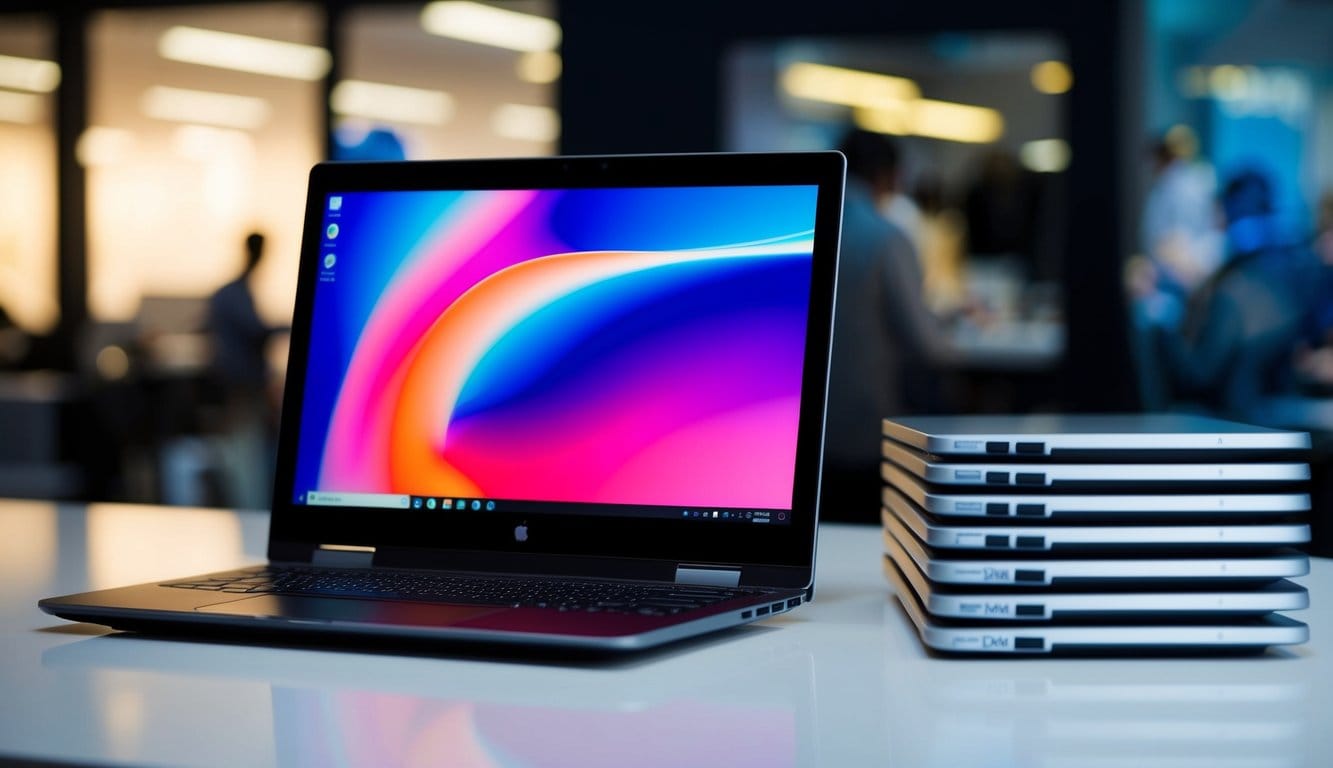When shopping for a new laptop, you might wonder why most models don’t come with OLED screens. These vibrant displays are popular in TVs and smartphones, so why not laptops too? Let’s dive into the reasons behind this choice in tech.
The main reason most laptops don’t use OLED screens is due to the issue of screen burn-in and limited lifespan. Although OLED displays offer superior color and contrast, they are more prone to screen burn-in compared to other technologies like LCD. This means that static images can leave a permanent mark on the screen, which is not ideal for devices like laptops that often display static interfaces.
In this article, we’ll explore the exciting world of display technology, comparing OLED and LCD screens, and examining their advantages and disadvantages. You’ll learn about how these technologies affect battery life, cost, and performance, helping you make a more informed decision for your next laptop purchase.
JUMP TO:
Understanding OLED Technology

OLED technology offers vibrant colors and deep blacks, setting it apart from traditional LCD screens. This section explores how OLED and LCD compare, the magic of OLED’s color capabilities, and what makes OLED’s refresh rates and response times notable.
OLED vs LCD: A Screen Showdown
OLED panels are like rock stars when it comes to color and contrast. Each pixel in an OLED screen emits its own light, which means inky blacks because they can turn off completely. LCDs, on the other hand, rely on backlighting, which can make blacks look more like dark grays. OLED screens also showcase a broader color gamut, supporting sRGB and DCI-P3.
While OLEDs are known for their image quality, the display supply chain has its hurdles. OLED displays are complex to produce, often making them pricier than LCDs. Additionally, OLED panels can face issues like burn-in, where static images persist. Despite these challenges, OLED technology continues to draw attention.
The Science of Inky Blacks and Bright Whites
OLED screens excel in providing a stark contrast between the darkest and lightest colors. This is mainly due to the way OLED technology works, where each pixel is its own light source. The absence of a backlight means true blacks are possible, which enhances the perception of brightness when whites are displayed. As a result, OLED displays achieve a striking image clarity and brightness.
This pixel-level control gives OLED displays a high dynamic range (HDR), making them a favorite for watching movies or playing games. Because of their self-lighting ability, these screens often seem brighter, even at lower brightness settings compared to LED displays. As a bonus, colors on OLED are vibrant and lifelike.
Refresh Rate and Response Time
The refresh rate and response time of a display can affect how smooth and responsive it feels. OLED screens often boast superior response times because they don’t rely on liquid crystals that need to twist and untwist as LCDs do. This means an OLED display can turn its pixels on and off faster, reducing motion blur.
Typically, OLED screens have refresh rates that match those of LCDs, but the real win is in response time, which is crucial for gaming and fast-paced video. Faster response times in OLED panels mean less ghosting and a sharper picture. This makes OLED a popular choice where visual performance matters most.
The Roadblocks for OLED in Laptops
Incorporating OLED displays into laptops faces several hurdles. These include the high cost of production, concerns about durability like burn-in, supply chain challenges, and battery life issues due to high power consumption.
High Cost and Durability Concerns
One significant obstacle is the high cost associated with OLED screens. Producing OLED panels is expensive due to their complex manufacturing process. As a result, OLED laptops often come with a hefty price tag, making them less accessible for budget-conscious buyers.
Another issue is the durability of OLED displays. These screens can suffer from burn-in, where static images leave a permanent mark on the screen after prolonged use. This can be a problem for users who use specific applications or menus that don’t change often.
Here are some key challenges:
- Expense: High production costs lead to expensive final products.
- Burn-In: Risk of permanent image retention.
This combination of high price and durability concerns makes OLED less appealing for many laptop manufacturers.
Supply Chain Shenanigans
The OLED display supply chain is another roadblock. Manufacturing OLED panels requires specialized materials and technology, which not all suppliers have. This limitation affects availability and can cause delays or shortages.
Additionally, not every laptop manufacturer has established relationships with OLED suppliers. This can make it difficult to secure the necessary components to produce OLED laptops at scale. Consequently, some manufacturers stick to LCD panels, which are easier to source and produce.
Here’s a look at the supply chain issues:
- Limited Suppliers: Few manufacturers can produce OLED screens.
- Sourcing Challenges: Relationships with OLED suppliers are crucial for securing materials.
These supply chain issues make OLED implementation in laptops a complex affair.
Battery Life: The OLED Achilles’ Heel
OLED laptops are also notorious for high power consumption. Unlike LCDs, which use a backlight, OLED displays illuminate each pixel independently. While this results in stunning visuals, it can significantly drain battery life.
Frequent travelers or remote workers may find shorter battery life a deal-breaker. This issue makes OLED laptops less practical for those who need a device to last through long sessions without recharging.
Important points on battery life:
- Power Drain: Independent pixel lighting increases energy use.
- Practicality Concerns: Reduced battery life can hinder mobility and convenience.
Thus, while OLED screens offer brilliant visuals, they demand much more from laptop batteries, posing a notable challenge for their adoption.
Advantages of OLED Screens in Laptops

OLED screens have a lot going for them, making them an excellent choice for specific users. They excel in color precision and bring media to life. These screens are great for gamers who want fast response times and brilliant visuals and are also perfect for content creators who need stunning color accuracy.
Seeing Is Believing: Color Accuracy and Gamut
OLED screens deliver unmatched color accuracy, making them ideal for users who need precise color management. The displays cover a wide color gamut, including sRGB and DCI-P3, which ensures vibrant and true-to-life colors. These displays also support HDR content, enhancing brightness and contrast. Wide viewing angles mean everyone in the room gets the same brilliant view without color shifts.
- Wide Color Gamut: sRGB, DCI-P3
- High Contrast and Brightness
- Wide Viewing Angles
Game On: OLED for Gaming Laptops
For gamers, OLED screens are a game changer. They offer fast response times and deep blacks, enriching the overall gaming experience. The rich colors and high contrast bring games to life, making scenes more immersive. Eye strain is reduced, allowing for longer gaming sessions. Gamers appreciate the quick transitions and vivid imagery that only an OLED laptop can deliver.
- Fast Response Times
- Deep Blacks
- Reduced Eye Strain
Media Maestros: OLED for Content Creators and Consumers
Content creators love OLED screens for their color-accurate display capabilities. They provide realistic visuals, crucial for media editing and creation tasks. These displays are also fantastic for media consumers, presenting HDR content with stunning clarity and vibrancy. Whether editing photos, videos, or enjoying a blockbuster, OLED makes everything look its best.
- Color-Accurate Display
- HDR Support
- Ideal for Photo and Video Editing
In essence, OLED screens in laptops offer unmatched advantages for those who value vibrant colors and immersive experiences, making them an ideal choice for both gamers and creative professionals seeking the very best in display technology.
The Current Landscape of OLED Laptops
OLED laptops are becoming more popular. They offer better colors and deeper blacks compared to traditional screens. Big brands like Dell, HP, and Apple use this technology in different ways.
Market Movers: From Dell XPS 13 to HP Spectre x360
Dell and HP lead the charge in OLED technology. The Dell XPS 13 is a standout. It has one of the best OLED displays around, providing rich colors for photography and design.
HP’s Spectre x360 also showcases OLED in its lineup. It offers great visuals for movies, gaming, and more. Not as famous as Dell, HP still pushes OLED displays into more homes. This makes OLED less of a luxury and more of a standard.
OLED technology shines in these models. It enhances user experiences through vivid imagery and better contrasts.
Apple’s Display Choices: MacBook Pro and Beyond
Apple took a different path. They focus on Retina and Mini-LED displays, avoiding OLED for the MacBook Pro. iPad Pro users enjoy a Mini-LED display, offering strong competition against OLED.
Why not OLED then? Apple’s alternatives excel in brightness, battery life, and longevity. Mini-LED displays match OLED in some areas, making their devices attractive without added costs.
People wonder if Apple will switch to OLED in the future. For now, they follow their own display path.
The Windows to OLED Adoption
Windows laptops see broader OLED adoption. Windows 11 supports the high contrast and vivid colors provided by OLED screens.
Microsoft teams up with manufacturers to leverage OLED’s advantages. This partnership creates laptops like Lenovo’s Yoga series, balancing performance and stunning displays.
OLED screens improve Windows-based laptops as they find a middle ground between performance and immersive visuals. Troubles like burn-in and shorter lifespan remain obstacles. But, ongoing advancements continue to refine OLED for Windows users.
Looking to the Future: OLED Evolution

OLED technology is transforming laptop displays with its vibrant image quality, providing inky blacks and exceptional color accuracy. Upcoming innovations promise even greater improvements in brightness and productivity. OLED could soon compete even more intensely with IPS displays as manufacturers address key challenges.
Innovations on the Horizon
OLED technology is on the brink of redefining the display landscape. Exciting developments focus on extending lifespan and efficiency, making OLED panels more attractive to consumers. Quantum dot enhancements are being explored to improve color precision and energy use.
These advanced solutions aim to reduce screen burn-in, a common concern among OLED users. MicroLED integration is another possibility being considered, providing OLED’s vibrant image quality with potentially longer life and higher brightness. As research into these areas continues, OLED screens are set to become a compelling choice for laptop manufacturers and users who demand advanced display technology.
Darkest Nights and Brightest Days: Improving OLED
Bringing OLED displays to more laptops requires overcoming some technical challenges. Increasing brightness without sacrificing energy efficiency is a major focus. By fine-tuning pixel-level controls, OLED screens can offer brighter displays suitable for various environments.
Achieving better HDR support is another goal for OLED technology. Current efforts are aimed at enhancing the contrast ratio, providing deeper inky blacks while maintaining sharp colors. This makes OLED a potentially better choice for users needing accurate visuals, from photographers to gamers. These advancements could make OLED displays more prevalent in laptops, matching and even surpassing competing display technologies like IPS.
The Next Generation of OLED Laptops
The transition to OLED in laptops is picking up pace, as manufacturers understand the potential for unmatched visual output. The latest OLED laptops are being designed with improved energy performance, making them more suitable for everyday productivity.
Manufacturers are also focusing on reducing costs, which is crucial for broader market adoption. As more computing tasks demand greater color accuracy and resolution, OLED is poised to address these needs efficiently. With continued evolution, OLED laptops are moving from niche to mainstream, promising a future where exceptional display quality becomes standard rather than a luxury.
Final Thoughts
Laptops might not be rocking OLED screens yet, but there’s a light at the end of the tunnel. OLED panels offer deeper blacks and more vibrant colors, which might leave users wondering why they aren’t more common.
Why Not OLED?
- Cost: OLED screens are expensive, pushing up laptop prices.
- Burn-In Risks: Static images can cause permanent screen ghosting.
- Limited Sizes: Suitable OLED screen sizes are rare, complicating production.
While OLED screens are common in smartphones and TVs, laptops are a different battleground. Technical limitations and costs mean that smaller, portable devices might be last in line.
But don’t worry, tech keeps marching forward! As production methods improve, more laptops could see OLED make an entrance. Until then, there’s plenty of room for existing tech to get even better.
There’s excitement about the future of display technology in laptops, but it’s a journey that takes time, patience, and a dash of innovation. Until flags fly at OLED high on every laptop, users continue to enjoy advances in LED and LCD tech, keeping colors sharp and spirits high.


